Content repurposing is a vital strategy behind successful content operations today. Whether you are a solo creator building your personal brand or part of a large content team at a major company, repurposing content effectively can multiply your reach and engagement. This article will guide you through creating an AI-powered content repurposing system using n8n, Apify, and Claude Sonnet. This system is fully customizable to fit your unique content needs, allowing you to adjust target platforms, tone, and writing style.
If you want to scale your content production and promotion without scaling your workload, this content repurposing factory is built for you. Be sure to join our free AI Automation Community to get the exact n8n workflow template and prompts to set this up yourself.
Why Build an AI Content Repurposing System?
Creating content is only the first step. To maximize your content’s impact, you need to distribute and adapt it across multiple channels. Repurposing content means taking one piece of long-form content — like a video or blog post — and transforming it into many smaller, platform-specific formats such as tweets, LinkedIn posts, newsletters, or Instagram carousels.
Doing this manually can be time-consuming and inconsistent. Automation powered by AI allows you to:
- Quickly generate multiple variations of content tailored for different platforms.
- Maintain consistent messaging while adapting tone and style for each audience.
- Scale your content marketing without increasing your workload.
This system leverages AI language models to analyze your original content and create optimized social media posts designed for engagement.
Overview of the Content Repurposing Workflow
The core of this automation starts with a piece of long-form content — in this case, a YouTube video. The system scrapes the video’s metadata and transcript, then uses that transcript to generate multiple social media posts tailored for Twitter and LinkedIn. However, the system is flexible enough to be adapted for other content types and platforms.
Here’s a breakdown of the workflow:
- Trigger and Input: The system starts with a simple form input where you provide the URL of the long-form content (e.g., a YouTube video).
- Scrape Content: Using Apify, the system scrapes the video’s metadata and full transcript, including subtitles with timestamps.
- Process Data: The transcript and metadata are cleaned up and formatted for easy use by the AI language model.
- Repurpose Content: The transcript is passed to separate workflows that generate engagement-optimized posts for different platforms, starting with Twitter and LinkedIn.
- Review and Share: The generated posts are formatted and shared to Slack for review, making it easy to copy, schedule, or post them manually.
This modular approach means you can add more social platforms or repurposing formats as needed.
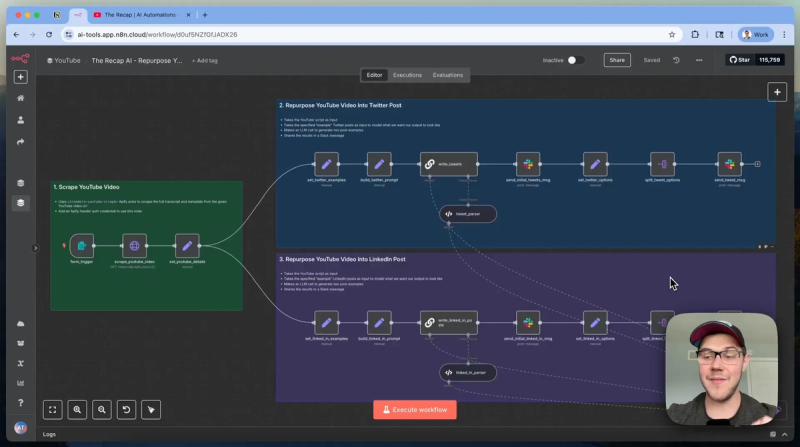
Scraping Video Transcripts with Apify
Scraping the transcript and metadata from your long-form content is the foundation of this automation. Apify provides a powerful scraping platform built around “actors,” which are mini-applications designed to extract data from various sources.
For YouTube videos, the “streamers YouTube scraper” actor pulls the video title, thumbnail, URL, and most importantly, the full transcript with subtitle timestamps. This transcript is essential because it contains the full text of what was said, segmented by time.
Here’s how the scraping process works:
- You provide the YouTube video URL as the input.
- The Apify actor runs synchronously, returning a single API response with all the video metadata and subtitles.
- The subtitles are provided in SRT format, which includes timestamps and the exact text spoken at each interval.
This detailed transcript enables the AI to analyze the content deeply and generate high-quality repurposed posts.
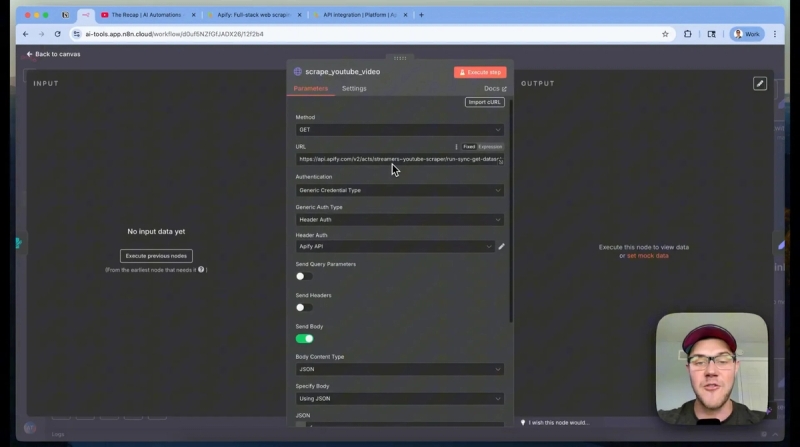
To authenticate your API requests to Apify, you set up a generic header credential with your API key. This ensures your requests are authorized and data returns smoothly.
Preparing Data for AI Processing
Once the transcript and metadata are retrieved, the next step is to clean and organize this data into a format that the AI language model can easily consume.
Key elements extracted include:
- Title: The video’s title for context.
- URL: The original content link.
- Transcript: The full subtitle text with timestamps.
This structured approach prevents the AI from needing to sift through unnecessary data and focuses its processing on what matters most.
Generating Engagement-Optimized Twitter Posts
With the transcript ready, the automation forks into different paths to create tailored social media content. Let’s start with Twitter.
Before generating tweets, we provide the AI with curated examples of past tweets that performed well. These examples serve as models for style, tone, and structure, guiding the AI to produce similar high-engagement posts.
The AI is prompted through a detailed multi-step process:
- Analyze source material: The AI carefully reviews the full transcript to understand the core value and message of the content.
- Study examples: It examines the provided tweet examples to learn their structure, tone, and psychological hooks.
- Generate tweets: The AI creates three unique, viral tweet options based on the analysis.
This approach ensures the tweets are not generic but strategically crafted to maximize engagement on Twitter.
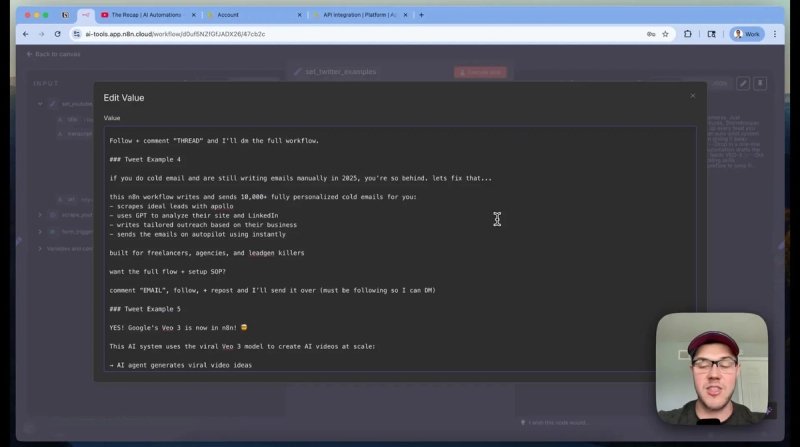
After the AI generates the tweets, they are formatted and shared to Slack for easy review. You can pick the best tweet to post or schedule it for later.
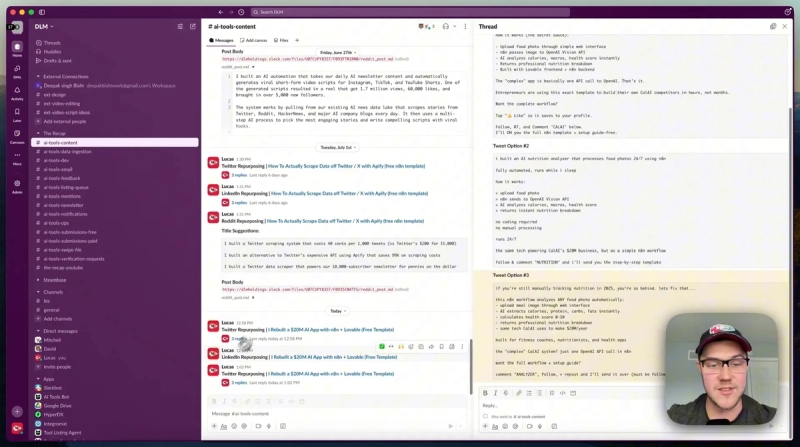
Creating LinkedIn Posts from Video Transcripts
The LinkedIn repurposing path follows a similar process but with key differences to match LinkedIn’s professional audience.
We provide a separate set of LinkedIn post examples that highlight a more formal tone, clear calls to action, and minimal use of emojis. The AI’s role is defined as a world-class B2B content strategist and LinkedIn growth expert, guiding it to produce posts that resonate with LinkedIn users.
The prompt instructs the AI to:
- Analyze the transcript to extract relevant insights.
- Study the curated LinkedIn post examples for style and structure.
- Generate three distinct LinkedIn post options optimized for engagement.
This ensures the content feels native to LinkedIn and maximizes professional engagement.
Like with Twitter, the LinkedIn posts are formatted and sent to Slack for review, making it simple to copy and publish.
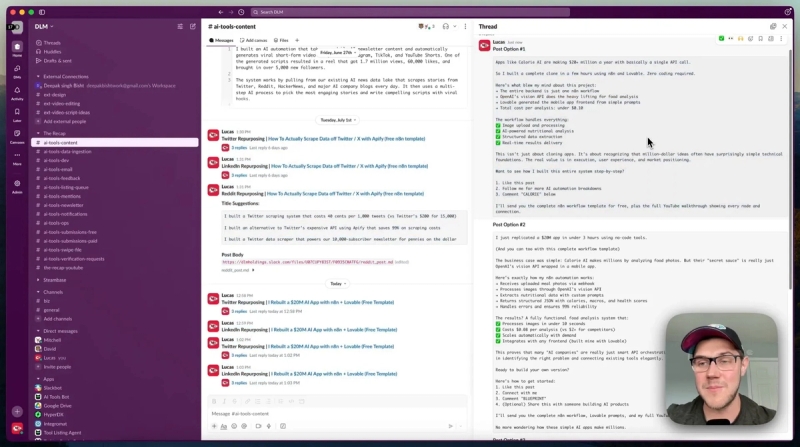
Customizing and Extending Your Content Repurposing Factory
The modular design of this automation means you can add new channels or content formats with relative ease. For example:
- Add an Instagram carousel post workflow by creating prompts and formatting tailored to that platform.
- Generate newsletter snippets or email marketing content from the same transcript.
- Automate posting directly to social platforms using their APIs after generating content.
By building on this foundation, you can create a comprehensive content multiplication machine that meets your specific marketing needs.
Conclusion
Building your own AI content repurposing factory empowers you to multiply your content output efficiently and effectively. Starting with a single long-form video or blog post, you can generate multiple tailored social media posts designed for engagement on platforms like Twitter and LinkedIn.
This system is flexible, customizable, and scalable. By carefully curating examples and crafting strong AI prompts, you ensure each piece of repurposed content is high quality and platform-appropriate.
Whether you want to automate your social media marketing or simply save time on content creation, this approach offers a practical solution that works.
Don't forget to join our AI Automation Mastery community to access the complete n8n workflow for free and get the prompts so you can launch your own content repurposing factory.





